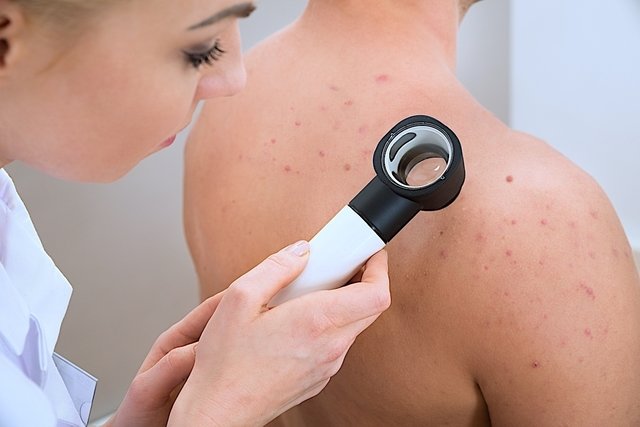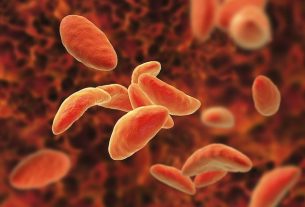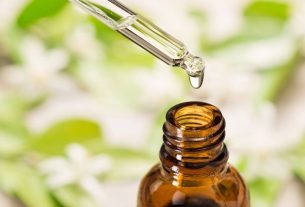White cloth is a skin infection caused by fungus Malassezia furfur which can cause symptoms such as white patches, itching and peeling of the skin, especially on the face, trunk, neck and arms.
Although it is part of the skin’s normal flora, this fungus can produce a substance that prevents the production of melanin, leading to the appearance of white spots, which is more common in people with oily skin, low immunity or genetic predisposition.
If you suspect white cloth, it is important to consult a dermatologist. Treatment may involve the use of antifungals in the form of soaps, ointments and, in more serious cases, tablets. Check out the most recommended medications for treating white cloth.

Main symptoms
The main symptoms of white cloth are:
- Circular, whitish spots on the trunk, neck or arms;
- Peeling of the skin over the spots;
- Disappearance of spots after summer;
- Itching at the location of the spots;
- Itching worsens in hot or rainy seasons.
Although sometimes the spots caused by white cloth can be reddish, they are usually oval and slowly increase in size, which can cause them to stick together to form larger spots over time.
Although white cloth generally causes few symptoms, if suspected, it is recommended to consult a dermatologist for an evaluation, as appropriate treatment depends on confirming the diagnosis. See other problems that can also cause white spots to appear on the skin.
How to confirm the diagnosis
The diagnosis is usually confirmed by the dermatologist taking into account the symptoms presented and the characteristics of the spots identified using a special lamp, called Wood’s lamp. See what the Wood’s lamp exam is and what it is for.
If you want to make an appointment, you can find the dermatologist closest to you using the tool below:
Taking care of your health has never been easier!
Especially when skin changes are not characteristic, the doctor may also recommend microscopic analysis of the skin’s peeling at the site of the march, which allows the identification of the fungus, confirming the diagnosis.
Possible causes
White cloth is usually caused by a fungus called Malassezia furfur, which is normally found on the skin, especially in oily areas such as the face, scalp and back without causing problems. However, due to changes such as the person’s genetic predisposition, heat and humidity, this fungus can multiply and cause the disease.
Furthermore, the risk of this fungus causing white cloth is greater during hot and humid seasons and in case of oily skin, excessive sweating, low immunity, pregnancy and in teenagers.
Is white cloth contagious?
White cloth is not considered a contagious disease, because the fungi that cause it are normally found on everyone’s skin and generally do not cause problems, except when they encounter conditions that favor their multiplication.
How the treatment is carried out
The main treatment options for white cloth are:
1. Antifungal soaps and shampoos
Soaps and shampoos containing 2.5% selenium sulfide, zinc or sulfur pyrithione and salicylic acid may be recommended and are capable of removing the layer of dead skin contaminated by the fungus from the surface of the body, gradually eliminating the fungus from the skin.
2. Antifungal ointments
Antifungal ointments composed of ketoconazole or terbinafine, for example, may be recommended due to their effect on eliminating the fungus and preventing its multiplication and are generally used for a period of 2 to 3 weeks.
3. Antifungal tablets
Antifungal medicines in tablet form, such as itraconazole and fluconazole, are generally indicated in cases where the spots affect large parts of the body or are recurrent even after adequate treatment.
However, some oral antifungals are generally less recommended, such as ketoconazole, due to its toxic effects on the liver, and terbinafine, as it is not effective in treating white cloth when used orally.
Bibliography
- BRAZILIAN SOCIETY OF DERMATOLOGY. Pityriasis Versicolor-(White Cloth). Available at: <https://www.sbd.org.br/doencas/pitiriase-versicolor-pano-branco/>. Accessed on 08 Nov 2023
- IN THE GROUP, Aditya K; FOLEY, Kelly A. Antifungal Treatment for Pityriasis Versicolor. J Fungi (Basel). Vol.1, n.1. 13–29, 2015
- STATPEARLS. Tinea Versicolor. 2021. Available at: <https://www.ncbi.nlm.nih.gov/books/NBK482500/>. Accessed on 01 Sep 2022
- PLENSDORF, Scott; LIVIERATOS, Mary; DADA, Nabil. Pigmentation Disorders: Diagnosis and Management. Am Fam Physician. Vol.96, n.12. 797-804, 2017
- SAUNTE, Ditte ML; GAITANIS, George; HAY, Roderick J. Malassezia-Associated Skin Diseases, the Use of Diagnostics and Treatment. Front Cell Infect Microbiol. Vol.10. 112, 2020





